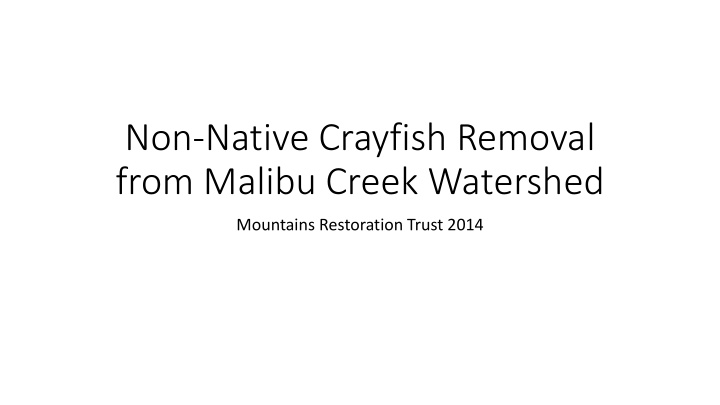



Non-Native Crayfish Removal from Malibu Creek Watershed Mountains Restoration Trust 2014
Committed to working in partnership with the community to preserve, protect, and enhance the natural resources of the Santa Monica Mountains for the benefit of the environment and for present and future generations through land acquisition and conservation easements; habitat preservation and restoration; and research and education.
Established in 1981 by the State Coastal Commission and the State Coastal Conservancy Became an Independent Non-Profit in 1984
Acquisition Restoration Education
Overview • Project funded by California Department of Fish and Wildlife (CDFW) • 4-year removal project that started in mid-June • Control of invasive Red Swamp Crayfish (Procambarus clarkii) population located in the Malibu Creek Watershed
Background • Crayfish introduced into M.C. watershed in early 20 th century • Used as bait for sport fishing (best guess) • Invasive species and a pest • Cause problems with native plants and animals in the streams http://eattheinvaders.org/wp-content/uploads/2013/09/pr_clarkii.gif
Invasive Species • According to CDFW, “Invasive species are organisms (plants, animals, or microbes) that are not native to an environment, and once introduced, they establish, quickly reproduce and spread, and cause harm to the environment, economy, or human health .” • USDA, CDFW, and several other organizations deal with management and prevention of invasive species
Why are they a problem? • Erosion • Burrowing behavior – excess sediment • Water Quality - Impairment • Competition for Resources • Predation of natives – Loss in Biodiversity www.appliedecology.co.uk • Crayfish will eat anything they can get their claws on • Eggs • Amphibians • Fish fry • Macroinvertebrates
How are we removing them? • Minnow Traps • Low impact on native reptiles and amphibians • Set out 24 hours before, keep out 24/7 • Barriers • Set up every 100-150 yards • Prevent migration of crayfish to other parts of the stream • Seine Nets • Stragglers left over • Capture crayfish that avoid traps
What happens to the Crayfish after? • Crayfish are humanely euthanized by freezing • Crayfish then given to CDFW approved wildlife rehabilitation center for feeding injured and recovering animals http://argiopephoto.com/?page_id=155
Logistics • Trapping 7 days a week • Trapping in 2 creeks so far • Las Virgenes Creek • Medea Creek
Barriers • Polyester Netting • Zip Ties / Wire • T-post every 5 to 6 feet • Weights/Rocks
What We Hope to Achieve • We want to have a low and manageable population of crayfish • Greater population of macroinvertebrates and www.mercurynews.com natureplayway.wordpress.com healthy indicator species • Higher water quality • A reduction in the level of trash in the streams nathistoc.bio.uci.edu
What we have done so far • Since the project inception (June 10 th ) we have removed over 428 pounds of trash and 27 pounds of recyclable materials • By removing trash we are taking additional steps in improving water quality • Removed >1,500 crayfish from 300 yards of stream in Las Virgenes Creek • Accrued >1,000 volunteer hours from our youth program and weekend activities
What the Community Will See • We hope that this project improves the community in many ways… • Improve Water Quality • Less treatment needed for recycled and wastewater services • Sustain revenue generating recreational and tourism opportunities • Increase attractiveness of stream • Increase in property value • Return of native wildlife • Increase quality of life
Community Action • We hope to get the Calabasas community involved in the restoration of their streams • How can they help? • Educate others about the health of streams • Take part in an Adopt-a-Stream program • Join us at our weekend crayfishing events
Adopt-a-Stream • Newly created program by Mountains Restoration Trust • The Calabasas community can get involved in restoring Las Virgenes creek • Groups select a section of stream to restore by removing crayfish and trash • Workshops will be offered to train project leaders
Contact Information • Website: http://www.mountainstrust.org • E-mail with questions or comments: • Anders Reimer areimer@mountainstrust.org Or • Kyle Troy ktroy@mountainstrust.org • Call us @ (818) 591-1701 extension 212
Recommend
More recommend